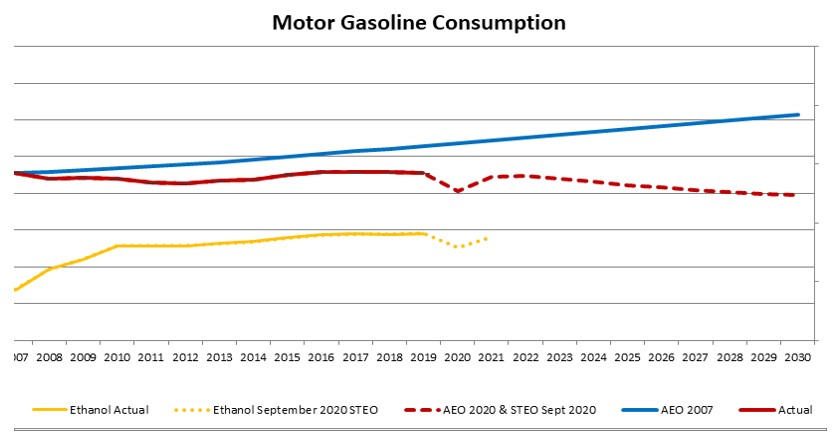
The Renewable Fuel Standard (RFS) is a government mandate, passed in 2005 and expanded in 2007, that requires growing volumes of biofuels to be blended into U.S. transportation fuels like gasoline and diesel every year. RFS mandates were written into law as specific volumes that do not scale to changes in U.S. fuel consumption trends. This feature of the law has resulted in U.S. refiners spending billions of dollars every year to attain compliance with the law — even though the vast majority of biofuels would still be blended without the mandate.
What did Congress intend for the RFS?
When Congress passed the RFS in the mid-2000s, domestic crude oil production had been in steady decline for more than three decades, the price of a barrel of oil was upwards of $100, and the federal government believed U.S. gasoline and diesel consumption would continue to increase. Policymakers feared that a continuation of those trends would lock the United States into a position of costly energy dependence. Lawmakers also believed that the development of advanced biofuels could reduce greenhouse gas emissions in the transportation sector.
But analysts’ two key projections — increasing fuel consumption and decreasing domestic crude production — did not happen. Technological improvements to internal combustion engine vehicles, liquid fuels, and engine lubricants flattened the gasoline consumption trendline. At the same time, the fracking revolution enabled domestic crude oil production to skyrocket and U.S. refiners grew capacity to historic levels, paving the way for the United States to become a net energy exporter.

Congress did not foresee the success story of fuel economy and declining fuel consumption coming into direct conflict with the RFS. But that problem scenario is what we’re now living with.
Ethanol and gasoline are not interchangeable. There is a limit to how much can be absorbed in the fuel supply, a dynamic known as the “blend wall.”
What Is the Blend Wall?
The blend wall is the maximum amount of ethanol that can be safely absorbed into the U.S. gasoline pool. Today, the blend wall sits at roughly 10 percent of total gasoline consumed. That 10 percent is a reflection of compatible retail infrastructure and consumer demand.
Ethanol is a valuable source of octane in finished gasoline, but it is chemically different than petroleum gasoline and cannot be used in concentrations above 10 percent in small engines — like outboard boat motors, motorcycles, lawnmowers, generators or chain saws — or in any cars made before 2001. Complicating matters further, most cars on the road today still aren’t warrantied to run on gasoline with more than 10 percent ethanol. Retail stations also must have compatible infrastructure in order to sell gasoline with higher ethanol blends. Until those factors change, and change significantly, the blend wall is likely to remain set at or around 10 percent.
Based on the volume targets set in the Energy Independence and Security Act of 2007 and the 2007 Energy Information Administration outlook available to policymakers at the time, it is clear Congress never intended for the RFS conventional mandate to exceed the E10 blend wall. Corn ethanol’s share of the mandate was supposed to remain just below 10 percent of the gasoline pool, at most.
Challenges of RFS Compliance
Fuel consumption is trending down, and the volume targets in the RFS now overwhelm the capacity of existing fuel and vehicle infrastructure. This makes RFS compliance increasingly expensive.
Individual refineries are required to pay for the RFS and spend billions of dollars every year satisfying the law by either:
- Purchasing or producing biofuels like ethanol, biodiesel and renewable diesel and then submitting credits (known as Renewable Identification Numbers, or RINs) to the Environmental Protection Agency (EPA) proving those purchases; or
- Purchasing second-hand RIN credits from parties that blended or imported biofuels directly.
For many refineries, RFS credits are a top annual expense, often exceeding total employee payroll. Every dollar spent on RFS credits is a dollar not supporting productive refinery work.
There is an old belief held by many in the biofuel industry that RFS compliance credits should be expensive. They presume that if RFS costs become too much for a refinery to bear, the facility will make the decision to invest in retail infrastructure upgrades to blend and sell more ethanol. That scheme would only work if every refinery was in control of ethanol blending terminals and gas stations. Many have no involvement in either.
Official government data shows there is no correlation between expensive RIN credits and increased ethanol blending. In 2019, credits were priced much lower than in previous years, but ethanol blending reached all-time highs. That’s because blending terminals (which purchase unfinished fuel from refineries) but generate no RFS obligations of their own add ethanol to almost all fuel in order make the finished gasoline that can be sold at retail.
Small Refinery Exemptions
Congress designed the RFS with an explicit directive for EPA to maintain relief lifelines for small refineries because of the essential role they play in America’s regional fuel markets. In fact, Congress exempted all small refineries in the early years of the program and the law now empowers EPA to extend to qualifying small refineries a complete exemption at any time.
Small refinery exemptions are a necessity and reveal the complexity and brokenness of the RFS mandate. Every available resource — the EIA, economists, the USDA — agree that SREs have not reduced total ethanol blending.
What SREs have done is ease the price of compliance credits and limit the volume of foreign biofuel imported to meet refiners’ obligations after the blend wall is hit each year.
Reallocation
Consumption and blending data show that small refinery exemptions have not inhibited the growth of domestic ethanol consumption. Regardless, EPA is frequently pressured to inflate annual RFS obligations to make up for past waivers. But there are no lost volumes to reallocate.
Individual refineries are the obligated parties under the RFS. If an individual refinery is exempted from having to submit RINs to the EPA because of demonstrated hardship, it is not fair or legal that the government would transfer their would-be obligation to other parties.
Fuel suppliers blend as much ethanol as consumers are willing to buy and as infrastructure can safely handle. Increasing RFS obligations through reallocation affects neither of those factors. However, reallocation does increase compliance costs and competition for RINs. It also results in expensive foreign biodiesel imports that replace affordable, American-made petroleum diesel. These costs come at the expense of refinery jobs, industry growth and global competitiveness.
A Better Way Forward
RFS mandates must be brought in line with today’s market realities. The volumes drafted by Congress in 2007 have proven not to work for today’s modern transportation landscape.
As we work to continue improving vehicle fuel economy and efficiency, AFPM believes that a transition from the RFS to a fuel-neutral, 95-RON octane performance standard could better address the needs of all stakeholders, and most importantly consumers in all 50 states.
Pagination
- Previous page
- Page 5





